GRB 990510 and a Solar Wind Problem
Extracted in late September 2002 from:
West Nile Virus
Latest update 04 Apr 2019.
Recent changes or additions are in bold.
Key Words: astrobiology, exobiology, gamma-ray bursts, nuclear photodissociation, solar wind
This page begins with a West Nile Virus arrival date problem, but migrates to a possible connection between GRB 990510 and a very unique space weather event..
The null hypothesis in the basic article is that there is no significant correlation between whatever Venus does and new outbreaks (of unknown origin) of West Nile Virus. The metric being used in the study is the time differential between Venus inferior conjunctions and initial cases of West Nile Virus in geographical regions where surface-to-surface transmission of the disease from other terrestrial regions is questionable.
1999 - United States
The first case of West Nile virus in the Western hemisphere has been
reported to have occurred in New York City (two dead crows) on June 29,
1999. The onset may have been about two weeks earlier. According
to a U.S. Government Accounting Office report(1), a veterinarian at Bayside
Veterinary Clinic (New York City area?) found crows with signs of
nervous system disorders in the mid-June to late July 1999 time frame. The
birds were treated. Those that survived were released.
Special Problem
If one chooses to think in terms of extraterrestrial pathogens entering Earth's upper atmosphere one to two months prior to their expression at the Earth's surface, then the upper atmosphere drop-in time frame (for the June 29, 1999 USA WNV bird deaths) would have been roughly April 29 to May 29. But, in the middle of that period, the angle between Venus and Earth with respect to the sun would have been on the order of 70 degrees. At that angle the solar wind should have blown Venusian particles, biological or otherwise, well clear of the Earth. See following diagram. This looks like trouble for the Venusian pathogen hypothesis.
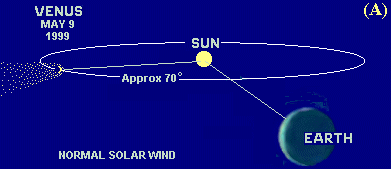
Venus-Sun-Earth angle approx 70 degrees - Normal solar wind.
On the other hand.... (Read: Save the Principle!)
An unprecedented solar wind disruption took place on May 10, 1999, which may have some bearing on the interplanetary particle delivery problem.
From late May 10, 1999 to early May 12, 1999, NASA's ACE and Wind spacecraft observed that the density of the solar wind dropped by more than 98 percent. See NASA's article: The Day the Solar Wind Disappeared.
I speculate that an unusually intense Gamma-Ray Burst (GRB 990510), which was detected about two hours before the solar wind disruption began, caused the disruption. This idea will be developed below.
The NASA article, referenced above, described a paucity of heavier ions in the solar wind. (Time frame not stated.)
"According to observations from the ACE spacecraft, the density of
helium dropped to less than 0.1% of its normal value, and heavier ions,
held back by the Sun's gravity, apparently could not escape at all."
On average it takes 4.3 days for ions to travel from the Sun to earth. If the sun began losing its acceleration vigor for heavier ions at about the same time as it's wind density began decreasing, then there should have been some remarkable corresponding electromagnetic perturbation in the Sun's appearance back around May 6th. The author has seen no reference to such an event. [Added 07 July 2003. Revised 05 Jul 2007; 11 Feb 2011.]
Gamma Radiation Induced Photodissociation of Atomic Nuclei
(Added 24 February 2003.)[Neutron mass intro reworked on 17 Jul 2017.]
In my opinion, which runs contrary to currently received theory, a neutron consists of a proton with an electron in a grazing orbit. (This viewpoint might make Heisenberg unhappy, but it is basically consistent with the 1920's idea of nuclear electrons.)
See Emission-Absorption-Scattering (EAS) Sub-quantum Physics and subsidiary articles, EAS Nuclear Glue and EAS Neutron Beta Decay.
If one is willing to consider nuclear electrons then there are at least two ways (both of which may be wrong) to account for the mass of a neutron (Mn) compared to the mass of a proton (Mp) plus that of an electron (Me).
(1) Special Relativity effect on the mass of the electron in orbit. Mn = Mp + 2.51 Me. (The 2.51 factor is the relativistic effect.)
When you solve the relation 2.51 = 1 / √ (1-v2/c2) for v, you get v = 0.918c.
Plugging this value of v into the following equation will give an electron orbit
radius on the order of 1.3 x 10e-15 meters and an orbital
frequency on the order of 10e22 Hz.
The part of this approach which is probably wrong is using special relativity effects for a body traveling in a nucleus sized circle.
(2) The EAS model approach.
In the EAS model, protons and electrons are said to be "opaque" (or mostly opaque) to the passage
of force producing chargelets.
With this in mind, an electron which is closely orbiting a proton, i.e., in a grazing orbit, will be
out of sight half the time from any given
other charge in the nearby environment. (It will be
shielded by the proton.) That means that it responds half as much to the
environment as would an
unbound electron. Half the response is equivalent to a doubling of effective mass.
This gives Mn ≈ Mp + 2.0 Me + proton-shielding-by-the-electron. (Deriving this last factor will take some work.)
Whenever the frequency of a wavelet of Gamma radiation happens to approximate the orbiting frequency of a nuclear electron, the radiation can electromagnetically pump energy into ... the electron's orbit. ... and ultimately lead to the electron's escape from the proton. (This is a classical idea and is analogous to pushing a school yard swing at the proper times to make it's oscillations increase in amplitude.) From the EAS viewpoint, the end result of this process would be another cause of neutron beta decay.
[A paragraph related to electron and proton departure speeds was removed on 11 Dec 2011.]
If the majority of the neutrons in a nucleus undergo beta decay, then the nucleus itself will rapidly fly apart due to proton-proton Coulomb repulsion. ( . . . ) leading to explosive photodissociation of the nucleus.
[Added 7 July 2006.]
GRB 990510 illuminated the solar wind disk from a point near the direction of the Southern celestial pole. It is speculated that the majority of the heavier nuclei in the solar wind underwent Gamma-driven photodissociation, which blew the solar wind apart. That the density of the heavier nuclei dropped to less than 0.1 percent of normal, can be attributed to the dissociation process, rather than to the Sun's loss of its ability to accelerate the ions above their escape velocities.
For info on GRB 990510 see the European Southern Observatory (ESO) press
release
Southern Fireworks above ESO Telescopes, 18 May 1999, and the South
African Astronomical Observatory (SAAO) press release
The Light of 5 Billion Billion Suns, 19 May 1999.
URL was http://www.saao.ac.za/no_cache/public-info/news/news/article/117/615/neste/30/?tx_ttnews[pS]=1128161770&cHash=10861ca44e83dd3b311b3df2966db471
Regardless of what caused the solar wind interruption, it is imperative to determine whether or not a two-day cessation could have permitted charged Venusian particles to jaywalk, so to speak, to Earth, as depicted in diagram (B).
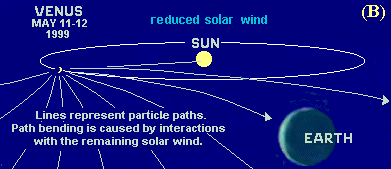
Solar wind reduction allows jaywalker event? (Revised Diagram)
The present delivery mechanism under consideration is that Venus, as an electrically charged sphere, can accelerate charged microscopic particles (including microbes from its upper atmosphere) sufficiently for them to make the roughly 100 million mile journey to Earth before the solar wind disk regained its normal density. For this transfer to work, as stated, the viral particles would have to be traveling away from Venus at approximately twice the average speed of the typical solar wind. On the other hand, charged particles and microbes which had been travelling at more or less right angles to the solar wind (or even mildly sunward) could have taken a more leisurely route. [Last sentence added 08 Jun 2009.]
Any jaywalking Venus viruses that reached Earth's upper atmosphere on around May 10-12, 1999 could conceivably have been doing their thing, i.e., initial outbreaks, in the mid-June to mid-July time frame. That's using the one to two months window mentioned above. The first reported cases of crows with nervous disorders (birds usually get it first) occurred in mid-June.
Diagram (C) shows the normal (on this web site) hypothetical delivery geometry for Venusian particles to Earth. (In this case the August 22, 1999 Venus inferior conjunction is being shown.) There was a resurgence of West Nile Virus in the United States in the September-October timeframe.
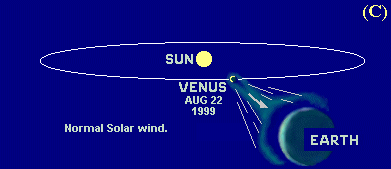
Normal Venus-to-Earth Delivery System
15-17 June 2003
A talk on this subject was presented in the 10th Annual Conference ofthe Natural Philosophy Alliance (NPA), at the University of Connecticut
at Storrs on 9 June 2003. The following additions to this web article are
made in response to questions and comments raised by the conferees.
It was stated above that nuclear electrons, having orbital frequencies on the order of 10^22 Hz could be electromagnetically "pumped out of orbit" by gamma radiation of the same approximate frequency. This means that an energy audit is in order. The purpose of the audit will be to see if gamma radiation and accepted binding energy ideas can account for the disintegration of a significant fraction of the heavier nuclei in the solar wind. [This paragraph needs some re-write.]
If we consider electromagnetic radiation to be comprised of photons, the following calculation for gamma photons of frequency 10^22 Hz is applicable.

Here is a table for binding energies of the lightest nuclides.

Based on energy considerations alone, the hypothetical 41 MeV gamma photons should be able to totally disassemble any of the light nucleons up thru Lithium, and cause serious trouble for more massive nuclei.
But then there is the matter of checking the GRB fluence (energy flux per unit area) against the number of candidate nucleons to be disassembled.
If we restrict ourselves to a very oversimplified scenario by pretending that the "heavier" nuclei in the solar wind are strictly deuterium nuclei we can make a rough estimate of how many nucleons could be involved in the gamma-induced dissociation process.
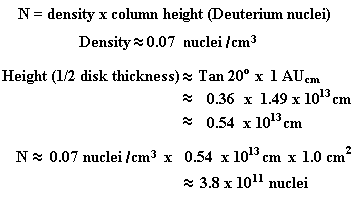
Keep in mind that the binding energy for a Deuterium nucleus is 2.22 MeV.
We then calculate how much energy GRB 990510 could apply to the problem. We use the BATSE fluence(2) for radiation above 20 keV.

It appears that, based on energy considerations alone, GRB 990510 could have induced a total of about eight dissociation events in the square-centimeter column with height equal to one-half the thickness of the solar wind disk.
If the numbers above are more-or-less in order, then we cannot apply accepted energy considerations to the problem of diffusing the solar wind external to the Sun itself.. That would leave the resonance-like pumping interaction of Gamma-radiation and hypothetical orbiting nuclear electrons as an open-ended adventure. (One other possibility, is that there was no direct en-route connection between the Gamma-ray Burst and the solar wind perturbation, and that something did in fact affect the Sun, itself, in some unknown way.)
With regard to the idea that the solar wind disk became less dense (enroute),I suggest that the rapidly disassembled nucleons may have caused the disk to expand explosively, above and below the ecliptic, which led to the temporarily rarified solar wind.
Timing Considerations
The normal solar wind speed is about 400 km/sec. At that speed it takes about one hour to for solar wind perturbations to traverse the 1.5 million km distance between the L1-region ACE spacecraft and the Earth-region WIND spacecraft. If the onsets of the solar wind density decreases, as recorded by these spacecraft, occurred within minutes of each other (instead of one hour) it would be compelling evidence that a Sun-based phenomenon was NOT the ultimate cause of the disruption.
The following graph shows ACE and WIND proton densities before and after GRB 990510. It's pretty hard to discern the comparative start times of the downward ramps of these curves, but to me, they look more-or-less coincident.
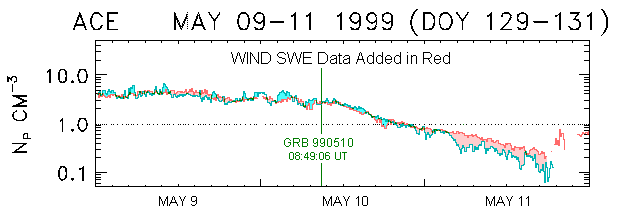
ACE and WIND SWE Proton Densities vs Time
Source:
http://www-ssc.igpp.ucla.edu/forms/polar/corr_data.html
For a more developed picture of the solar wind event see ACE-WIND 09-12 May 1999.
References
(1) [PDF] Timeline of Key Dates and Events in the West Nile Virus Outbreak, 1999.
(2) Michael S. Briggs, Robert D. Preece, Jan van Paradijs, Jean in 't Zand, John Heise, Erik Kuulkers and C. Kouveliotou, "Wide-Band Spectroscopy of GRB 990510," Gamma-Ray Bursts - 5th Huntsville Symposium, (1999) AIP Conference Proceedings, 526, 125-129.
Related Articles and Web Pages
Energy Burst from An X-Ray Star Disturbed Earth's Environment - Stanford University
Courtesy Science Blog - (2004)
Postscript
Ritzian Gamma-Ray Bursts
Sampling of recent papers on Photo Induced Nuclear fission.
(These deal with heavy nuclei.)
"Gamma-Ray induced fission and the Production of Technetium in Red Giants."
T.E. Cowan et al., (2000) Phys. Rev. Lett. 84, 903.
Deals with gamma-induced fission of 238U.
S. Fan, A. Wagner, E. Grosse, "Postneutron Yield of Bremsstrahlung-Induced Fission of 238U with an
Endpoint Energy of 12 MeV".
URL was http://www.fz-rossendorf.de/FWK/jb00/fan1.html.
W.D. Ledingham, R.P. Singhal, P. McKenna, I. Spencer, (2002), Europhysics News Vol. 33 No. 4. "Laser-induced nuclear physics and applications."
Papers on Gamma-Ray Induced Nuclear Photodissociation.
(These deal with light nuclei.)
Kikuchi, Sheishi, "Nuclear Photodissociation by High Energy Synchrotron Gamma-Rays," Phys. Rev., 86, 41-51 (1952) - NADS
Shade Tree Physics
Send comments/inputs to Robert Fritzius atfritzius@bellsouth.net
Top